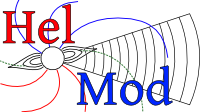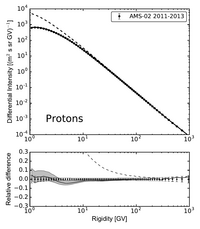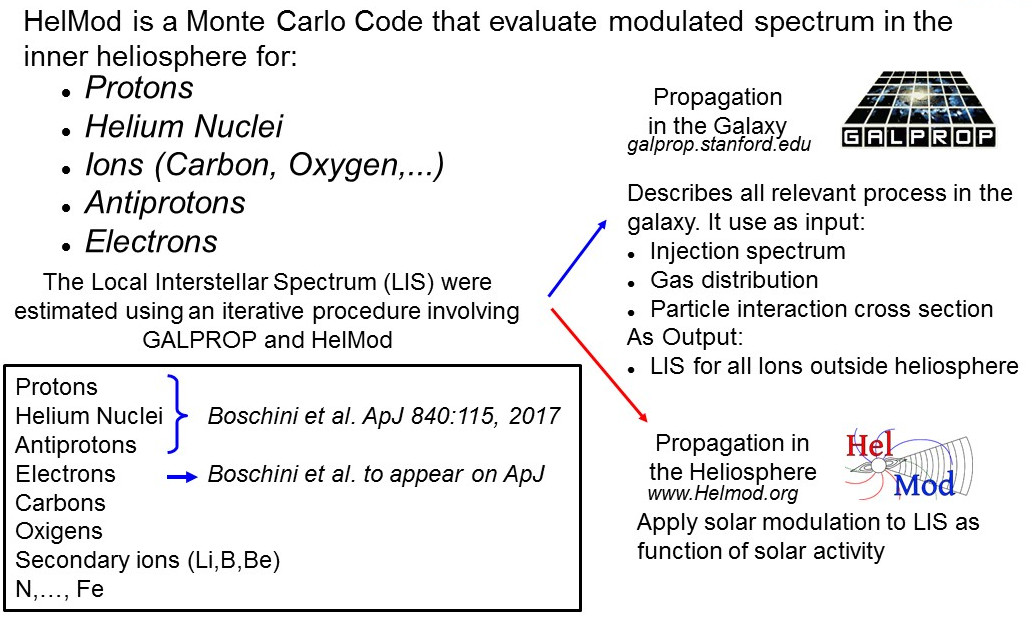Differential intensity integrated over the mission duration and forecast.
This site provides access to the main HelMod web calculator - which is an application of the latest available HelMod Code - for unregistered users, e.g.,
HelMod data sets and results can be freely downloaded or copied. However, we strongly suggest the user provide an appropriate acknowledgement and/or citation, e.g., see Citations or Bibliography pages.
Disclaimer: No Warranty. THE SOFTWARE IS PROVIDED "AS IS" AND WITHOUT WARRANTY OF ANY KIND. Simulation results are public domain. Developers and maintainers of HelMod-4, and respective institutions, shall have no liability for the use of HelMod-4 products. For official space qualification purposes please refer to space agency requirements.
How to use this HelMod Calculator
This tool evaluates the modulated spectrum at Earth orbit for theoretical LIS evaluated with GALPROP. The particle transport is described using the Helmod Model. For information about the computation method please refer to Monte Carlo Integration page.
The input parameters and options for the tool are described below. Once the input form has been completed, the "Submit" button will start the calculation and open the "Results" page (allow for a pop-up in your browser settings).
Expected Mission Duration/ Past Missions
Users can select either the time interval for the interested simulation or refer to a standard published dataset (e.g., AMS-02).
- Expected mission duration: allow for selecting a single Galactic Cosmic rays species and the expected duration of the mission. By default, the module evaluates the modulated spectrum for a single Carrington rotation containing the "begin of the mission" value. To evaluate the average modulated spectra over the entire period of the mission, check the box "Average over the entire period" and select the date of the end of the mission.
- Past missions: allow to compute of modulated spectra referring to period and GCR species described in standard published datasets. Users may select, in order, the Experiment (e.g. AMS-02), then the GCR species (e.g. Proton) and finally the published dataset.
Display Options
- x-axis value: Select if the output result should be computed in Particle Rigidity [GV] or in Kinetic Energy per nucleon [GeV]. If "auto" is selected, the system will choose the best one for the selected dataset.
Result
The result page contains the figure of the modulated spectrum and correspondent tabulated data.
Advanced Controls:
For expert users, it is available the possibility to modify some relevant HelMod parameters.
Available parameters may change for different HelMod versions. For the latest default parameters please refer to Current and History of default parameters page.
HelMod provides optimized LIS developed with GALPROP and presented in international journals, Expert users may load their own developed LIS. HelMod accepts the following formats:
- GALPROP fits file (*.gz extension). The fits must contain at least the computed LIS for the Galactic Cosmic Rays particle species to be modulated. The Module evaluates the LIS for modulation as the sum of modulated primary spectrum with secondaries and modulated isotopes.
- plaintext file. Users can provide a txt file for LIS with the following characteristics:
- The file should have a mime type 'text/plain' (Check out this list for allowed extensions).
- The file must contain two columns only: one for kinetic energy per nucleon [GeV], the second for the LIS flux [ (m\(^2\) s sr GeV)\(^{-1}\)].
- The file can contain comments. Line starting with '#' character will be ignored.
It should be remarked that data generated by using the Calculator may be used by HelMod developers for statistical purposes.



